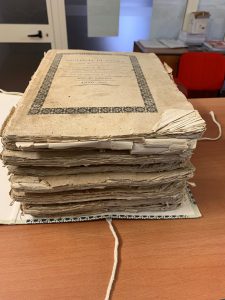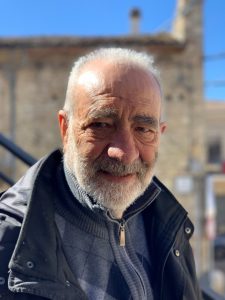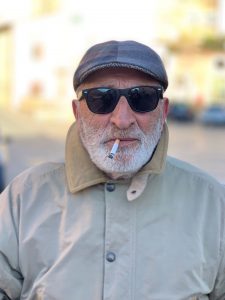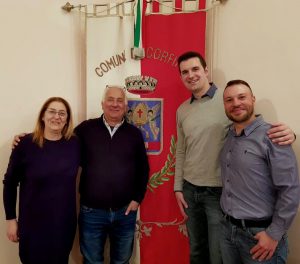 Standing in front of the town flag at town hall. With, from left to right, Cristina Colella (town assessor), Massimo Colangelo (mayor), and Giovanni Presutti (vice mayor).
Standing in front of the town flag at town hall. With, from left to right, Cristina Colella (town assessor), Massimo Colangelo (mayor), and Giovanni Presutti (vice mayor).
As I mentioned in my last Vita Brevis post, I was lucky enough to spend a few weeks in Europe this past March. Like any good vacation, my travels were filled with historical and genealogical research. After a wonderful stay in Rome and having thoroughly (re)explored its ancient history, I made my way to the Tiburtina Terminal in the northeastern part of the Eternal City to board a bus and pursue what historians and genealogists alone would consider recent history: nineteenth-century records.
As any Italian genealogist knows, many records that have been digitized are available on FamilySearch.org and the Italian Antentati (i.e. “ancestors”) site. The digitization process is far from complete, however. Only records held by the State Archives (and only for some provinces) have been digitized. Most towns retain documents in their town halls for as long as possible, and only send their oldest documents to the State Archives.[1] In the case of my ancestral town, Corfinio, the civil records from 1809–65 have been digitized and are accessible online. No records from 1865 onward are available, however, and they have (seemingly) never left the town hall since the time of their composition. It is therefore impossible to compile an accurate and complete family history when relying only on materials that can be accessed online and in the United States. To produce an accurate family tree, it’s essential to pull a disintegrating volume from the shelf, savor the smell of the dust, and flip through those rough, ink-blotted pages.
My great-grandparents were born in the early 1880s in Corfinio. Vital records for their parents, grandparents, aunts and uncles, brothers and sisters, cousins, nieces and nephews, godparents, and friends all appear in the post-1865 period – innumerable details are beyond the contents of the digital archive. Examining the records in Corfinio would reveal many important genealogical details, and it would also guarantee the creation of a duplicate copy of those unique documents.
One of the advantages of traveling da solo is that you have complete control over how you will spend your time. I must acknowledge that my time in Corfinio was successful because of the help of many friends and cousins. Prior to my arrival, I had been in touch with Alessandro Gasbarro, a friend of relatives and a native of Corfinio who now lives just outside of Boston. He contacted some of his friends in Corfinio who warmly received me.
I reached out to many Ferzoco cousins to coduct prelimary research on their lines. Alessandra (Ferzoco) Aquino introduced me online to her friend, Giovanni Presutti, who happens to be the vice-mayor of the town. I also “friended” the mayor, Massimo Colangelo, and other locals on Facebook in advance of my trip. I met up with all of these people over the course of the five days I spent in this sleepy town of one thousand inhabitants. I reached out to the last male Ferzoco in the town, my grandfather’s aging second cousin, Ezio Ferzoco, to let him know that I would be in town and we should collaborate. One afternoon we shared our findings with each other.
I stayed at the town’s hotel-restaurant operated by distant cousins, Francesco Colella and his sister Cristina. All of these individuals and many others enthusiastically welcomed l’americano in pursuit of his family history. My name helped – an introduction automatically revealed to the locals that I had ancestry in Corfinio; Alessandro is their patron saint and Ferzoco is a surname that appears in the records of the town going back 439 years (to when the ecclesiastical archive begins in 1580).
*
My first full day in Corfinio, I met Giuseppe “Peppe” Marrama -- the self-proclaimed capo of the town (who knows if he was joking!). He was thrilled to hear that I was a Ferzoco. Forty years ago, he had dated a woman who shared my surname. Peppe immediately announced that since I was a relative of his old sweetheart, he would do whatever he could to help me accomplish my research goals. I explained that I was hoping to collect as many records relating to the Ferzoco family as I could.
Within minutes, Peppe marched me up to the town hall (which is really one room) and presented me to the two administrators who guarded the records, Emilio and Loreto. He declared that I had come all the way from America to research my family and that they should allow me as much time as necessary at the town hall. They were not particularly enthusiastic about this proposition, but Loreto had married Peppe’s niece, which obliged him to honor the request of his zio. I expressed my appreciation for the opportunity and said that I wouldn’t bother them that morning and that I would try to hide my presence as much as possible. Later in the afternoon, I met Giovanni Presutti (the vice-mayor) for coffee and sambuca. Giovanni insisted that we return to the town hall. He told Loreto and Emilio that I was doing important work, and sat with them to break the ice while I initiated my research. Giovanni implored them to allow me to return the next day.
My request was unusual and something of an imposition, I’ll admit. Loreto and Emilio were not used to a stranger spending hours each day in their office. I assured them that I did not need supervision, that I was a trained professional, and that I would not interrupt their business. They were a bit wary at first, but as time passed, they realized that I would cause little interruption to their regular routine. After the second day, I started laughing at their jokes and occasionally joined in conversation. They appreciated my ability to speak Italian, and although they still looked at me with some skepticism, they brought me espresso and pastry my last morning there. Patience and persistence pay off!
I backed up my photos digitally and, in the evenings, I made detailed notes about the research I had accomplished that day.
I could write so much more about my few days in Corfinio, but because this is a genealogical blog I want to leave readers with a few lessons I learned and beliefs that were reaffirmed by my genealogical adventure in Corfinio.
- I charged my iPhone to 100% each morning before I arrived, so that I could capture images nonstop. Over the course of four sessions, I managed to capture all the births (most of which include a death annotation, and sometimes information about immigration) and most of the marriages relating to my surname from 1865 to the present.
- I captured indices whenever possible for future reference and for cousin lines that rely on other surnames, since it was impossible to capture every page of every volume in the amount of time I was present.
- When lunch time rolled around I dismissed myself for the day from the town hall, and left the town administrators alone in the afternoon.
- I backed up my photos digitally and, in the evenings, I made detailed notes about the research I had accomplished that day.
- I set goals; my chief goal was to locate all birth records from 1865 onward.
- I knew when to quit; I didn’t get everything, but I got more than I thought I would.
- I met dozens of locals. In a small town, everyone knows everyone else. It helps to have friends who can advocate on your behalf, and it makes it easier to return in the future.
- The American obsession with genealogy isn’t universal – for many people, including the locals in Corfinio, knowing one’s family history is often almost innate. The details of the records aren’t as important – they know where they come from, they have a deep sense of rootedness. Even if they don’t know exactly how they are connected, they know who their distant cousins are.
- I took advantage of opportunities to get genealogical information in regular conversation – over pasta at lunch, at the bar, walking through the cemetery, etc. People love to chat about their family history, and verbal histories can really complement and advance the record search.
Now for the fun part – drawing up all the results up in a tree, or maybe a book!
Note
[1] For earlier records, researchers must rely on religious documents, which are housed in separate ecclesiastical archives – I have used such records to trace my own patrilineal ancestry back to the late 1500s.
Share this:
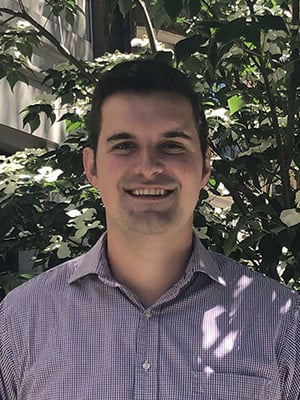
About Alessandro Ferzoco
Alessandro graduated from Harvard University with an A.B. in History. While a student, he worked at Widener Library assisting patrons with research and training new employees. He is a lifelong resident of Boston, and enjoys local and social history. He is particularly interested in New England, Irish, and Italian ancestries. In 2017 he traveled to Italy to conduct research, and he has traced his patrilineal family to the early 1600s. He enjoys deciphering manuscripts and Latin parish records.View all posts by Alessandro Ferzoco →
